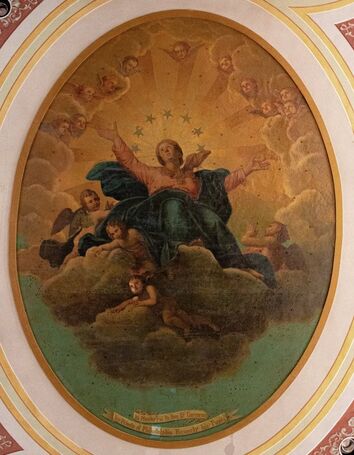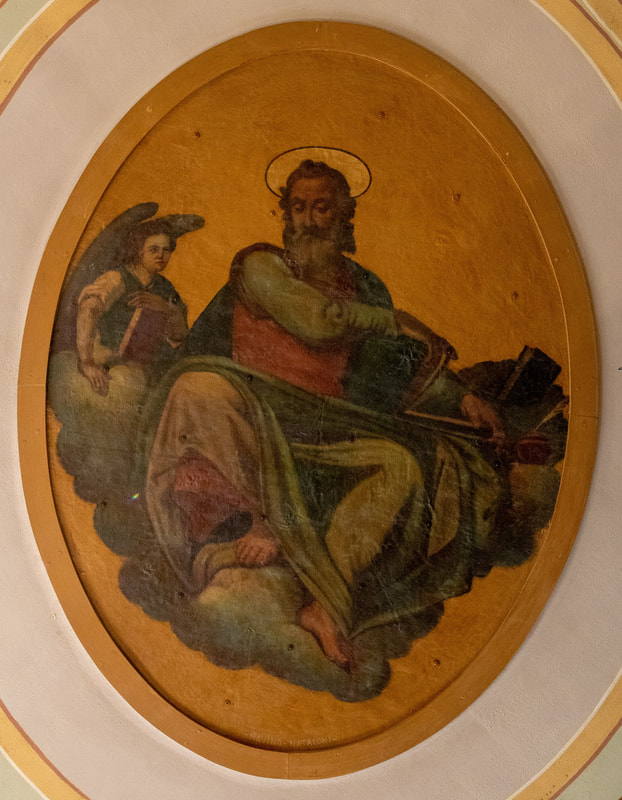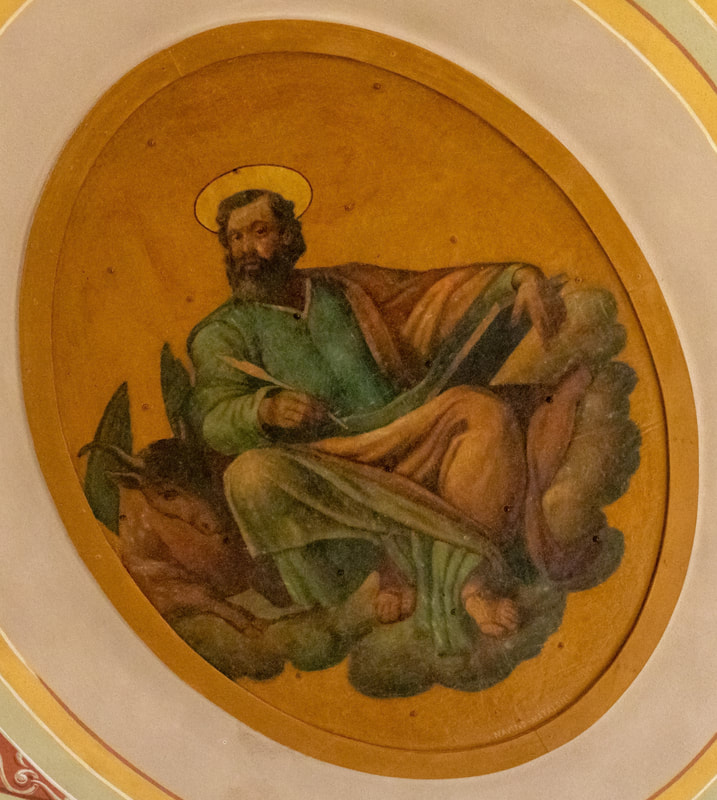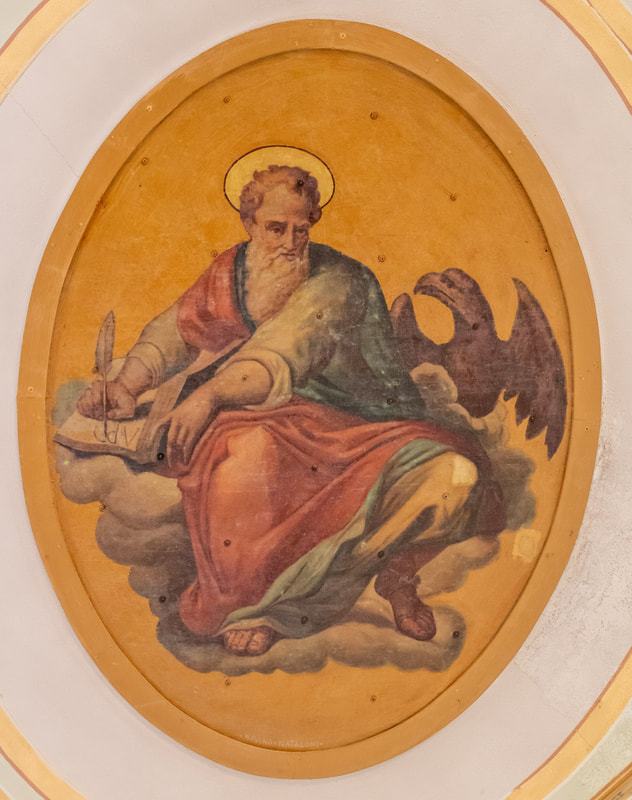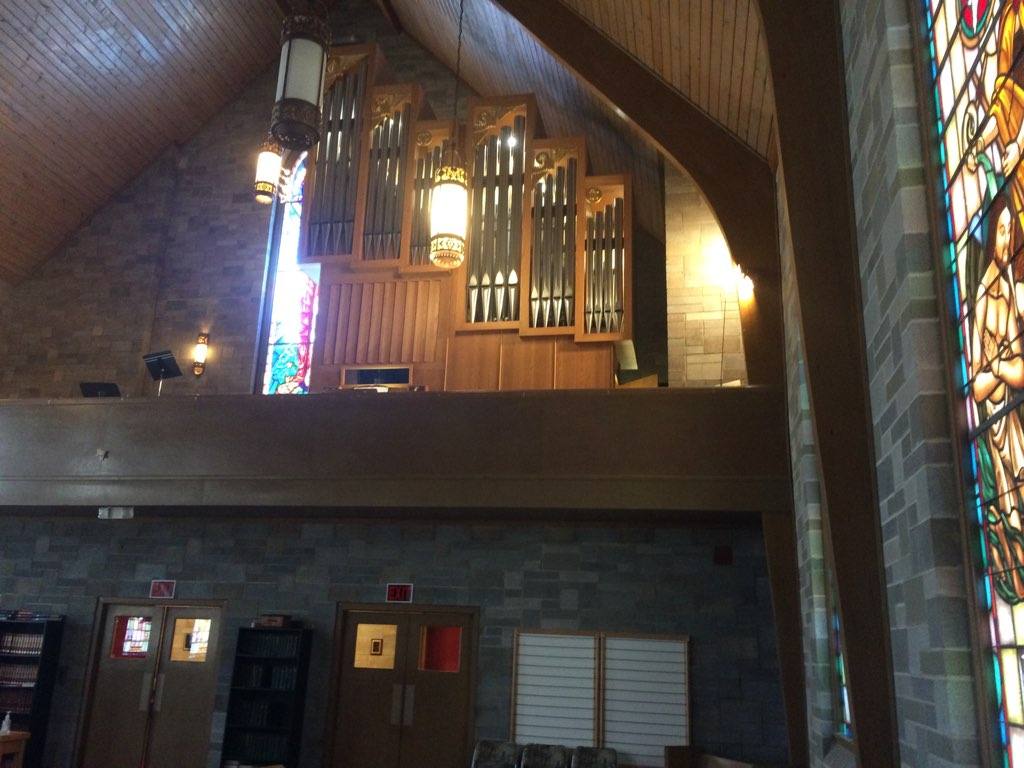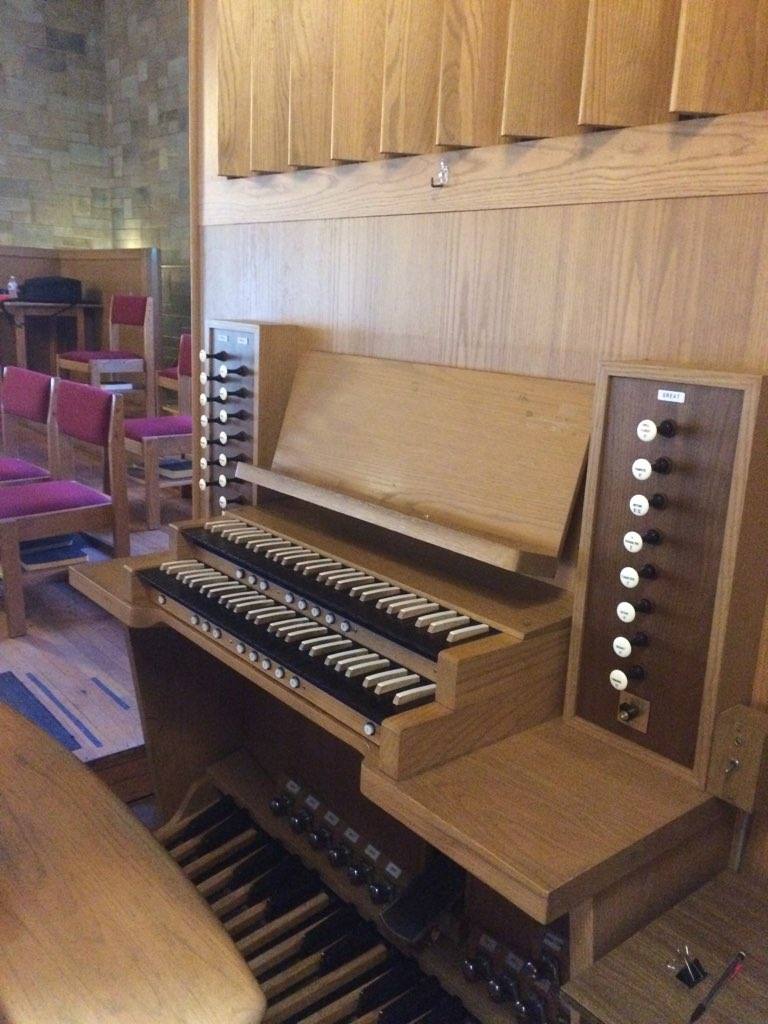This page and the following linked pages are in the process of being updated; thank you for your understanding!
Photos are forthcoming.
Visit the 'Our History' page for a basic history timeline.
Visit the 'detailed parish history' page for a more detailed history, including references (many of which are available online).
Visit the 'Photos' page for photos.
Visit the 'Graveyard' page for more information about the historic graveyard.
Visit the 'Bicentennial Campaign' page for more information on our current renovation/restoration work.
Detailed essays by parish historians:
Paintings (pdf)
Stained glass (pdf)
Organs (pdf)
Artwork restoration reports, courtesy of Catherine Rogers (pdf files):
Six of Twelve Apostles (balcony)
Angel #1 (sanctuary)
Adoration (sanctuary)
Angel #2 (sanctuary)
Crucifixion (sanctuary)
Angel #3 (sanctuary)
Resurrection (sanctuary)
Angel #4 (sanctuary)
Holy Spirit (sanctuary)
St Mary of the Annunciation, Charleston, SC - Art and Architecture Timeline
1788: Fr Matthew Ryan, the first priest to reside in Charleston, sent from Dublin by Fr Carroll. Fr Ryan rented a wood frame building on Hasell St.
1789: Fr Ryan left Charleston due to ill health; replaced by Rev Dr Thomas Keeting. Fr Keeting oversaw purchase of the Hasell St property.
1791: Fr Keeting also fell ill and left Charleston for Philadelphia, leaving the parish without a priest.
1793: Bishop Carroll sent Fr Simon Felix Gallagher to Charleston.
1806: Fr Gallagher oversaw replacement of the wood-frame building with a brick one. Organ #1 installed.
1814: Local artist John S Cogdell painted the Crucifixion as a gift to the parish.
1838-39: The Great Fire of 1838 destroyed St Mary’s church. The Crucifixion was saved but badly damaged; Mr Cogdell repainted it on the same canvas • The third and current building, a stucco-covered brick structure in the Classical Revival style (capacity ~250), was completed in 1839. Organ #2 installed. Sanctuary ceiling painted (Giovanni Chizzoli, Charleston).
1846: Side altar to the Blessed Virgin donated (replaced in 1905).
1860s: St Mary’s escaped the Great Fire of 1861, but Union shelling of the city in 1863 damaged walls and destroyed organ #2 • Organ #3 (Henry Erben, New York) installed in 1867 and destroyed in the Earthquake of 1886 (balcony damaged and rebuilt).
1884: Sanctuary and nave painted with floral, filigree, etc patterns; newly-installed ceiling painted blue with gold stars (John E Dohen, Charleston). New pews and gaslight fixtures added.
1895-96: First large renovation undertaken by parishioners: Installed organ #4 (a Hook & Hastings, Boston); new marble altars (consecrated by Bishop John Moore of St Augustine), floor, statues, communion rail, and baptismal font; stained glass windows (Franz Mayer, Munich); and paintings (Cesare Porta, Rome) with filigree-style painted ‘frames’ (H Mastin Batchelder, Charleston). Parapet wall added to roof. Nearly all of these pieces are still there today • Stations of the Cross paintings listed as ‘in hand’. Altars consecrated on March 25, 1896, the Feast of the Annunciation.
1901: Church consecrated in 1901 by Bishop Henry Northrop. Twelve painted consecration crosses visible inside (repainted since) • Pew box doors removed.
1905: The second major renovation primarily shortened the balconies. New side altar dedicated to the Blessed Virgin Mary donated, and four statues; all pieces still present.
1928: The third major renovation consisted of the addition of a new sacristy to the back of the church, the conversion of the former side-sacristies into space for the side altars, and the installation of eight additional stained glass windows. This renovation required removing walls and relocating two paintings and four stained glass windows elsewhere within the church. All pieces still present. East confessional cut for radiator installation (probable earliest date).
Mid-late 1900s: Many additional changes made to artwork - sanctuary ceiling/walls and nave ceiling completely overpainted several times; many of Porta’s works partially overpainted. Wooden crucifix added (earliest mention 1943); organ #5 installed (a T Howard Sheehan, Charleston, c1950). Parish hall building purchased (1969). Organ #6 installed (1980; an 1874/1894 Jardine, New York, restored by Mann & Trupiano, New York). This instrument is still in place. Stations of the Cross restored (1990’s). Interior lighting fixtures, particularly for the balcony, changed half a dozen times.
1976: St Mary’s listed on the National Register of Historic Places.
2000-2010s: Exterior columns painted faux-marble, cross gilded (2001); current altar and lectern installed; rectory building renovated.
2017: Inventory of the graveyard led by parishioner Michael Wilson with the help of other parishioners and College of Charleston graduate students, under the guidance of Professor Frances Ford.
2020-present: The fourth major renovation is in progress. Exterior columns restored to solid white. Both sacristy and parish hall have been completely renovated. Half of Porta’s paintings restored (reports here); reredos of High Altar removed. Sanctuary ceiling repainted by Craig Crawford, based on old photographs and paint analysis, to early-1900 design. Remaining large projects of note: Restoration of remaining paintings; installation of a new organ, gifted by Advent Lutheran Church and currently in storage (W Zimmer & Sons, rebuilt by Cornel Zimmer, Denver, NC), remodeling of the choir loft to accommodate the organ; and refinishing of pews and floor area.
Photos are forthcoming.
Visit the 'Our History' page for a basic history timeline.
Visit the 'detailed parish history' page for a more detailed history, including references (many of which are available online).
Visit the 'Photos' page for photos.
Visit the 'Graveyard' page for more information about the historic graveyard.
Visit the 'Bicentennial Campaign' page for more information on our current renovation/restoration work.
Detailed essays by parish historians:
Paintings (pdf)
Stained glass (pdf)
Organs (pdf)
Artwork restoration reports, courtesy of Catherine Rogers (pdf files):
Six of Twelve Apostles (balcony)
Angel #1 (sanctuary)
Adoration (sanctuary)
Angel #2 (sanctuary)
Crucifixion (sanctuary)
Angel #3 (sanctuary)
Resurrection (sanctuary)
Angel #4 (sanctuary)
Holy Spirit (sanctuary)
St Mary of the Annunciation, Charleston, SC - Art and Architecture Timeline
1788: Fr Matthew Ryan, the first priest to reside in Charleston, sent from Dublin by Fr Carroll. Fr Ryan rented a wood frame building on Hasell St.
1789: Fr Ryan left Charleston due to ill health; replaced by Rev Dr Thomas Keeting. Fr Keeting oversaw purchase of the Hasell St property.
1791: Fr Keeting also fell ill and left Charleston for Philadelphia, leaving the parish without a priest.
1793: Bishop Carroll sent Fr Simon Felix Gallagher to Charleston.
1806: Fr Gallagher oversaw replacement of the wood-frame building with a brick one. Organ #1 installed.
1814: Local artist John S Cogdell painted the Crucifixion as a gift to the parish.
1838-39: The Great Fire of 1838 destroyed St Mary’s church. The Crucifixion was saved but badly damaged; Mr Cogdell repainted it on the same canvas • The third and current building, a stucco-covered brick structure in the Classical Revival style (capacity ~250), was completed in 1839. Organ #2 installed. Sanctuary ceiling painted (Giovanni Chizzoli, Charleston).
1846: Side altar to the Blessed Virgin donated (replaced in 1905).
1860s: St Mary’s escaped the Great Fire of 1861, but Union shelling of the city in 1863 damaged walls and destroyed organ #2 • Organ #3 (Henry Erben, New York) installed in 1867 and destroyed in the Earthquake of 1886 (balcony damaged and rebuilt).
1884: Sanctuary and nave painted with floral, filigree, etc patterns; newly-installed ceiling painted blue with gold stars (John E Dohen, Charleston). New pews and gaslight fixtures added.
1895-96: First large renovation undertaken by parishioners: Installed organ #4 (a Hook & Hastings, Boston); new marble altars (consecrated by Bishop John Moore of St Augustine), floor, statues, communion rail, and baptismal font; stained glass windows (Franz Mayer, Munich); and paintings (Cesare Porta, Rome) with filigree-style painted ‘frames’ (H Mastin Batchelder, Charleston). Parapet wall added to roof. Nearly all of these pieces are still there today • Stations of the Cross paintings listed as ‘in hand’. Altars consecrated on March 25, 1896, the Feast of the Annunciation.
1901: Church consecrated in 1901 by Bishop Henry Northrop. Twelve painted consecration crosses visible inside (repainted since) • Pew box doors removed.
1905: The second major renovation primarily shortened the balconies. New side altar dedicated to the Blessed Virgin Mary donated, and four statues; all pieces still present.
1928: The third major renovation consisted of the addition of a new sacristy to the back of the church, the conversion of the former side-sacristies into space for the side altars, and the installation of eight additional stained glass windows. This renovation required removing walls and relocating two paintings and four stained glass windows elsewhere within the church. All pieces still present. East confessional cut for radiator installation (probable earliest date).
Mid-late 1900s: Many additional changes made to artwork - sanctuary ceiling/walls and nave ceiling completely overpainted several times; many of Porta’s works partially overpainted. Wooden crucifix added (earliest mention 1943); organ #5 installed (a T Howard Sheehan, Charleston, c1950). Parish hall building purchased (1969). Organ #6 installed (1980; an 1874/1894 Jardine, New York, restored by Mann & Trupiano, New York). This instrument is still in place. Stations of the Cross restored (1990’s). Interior lighting fixtures, particularly for the balcony, changed half a dozen times.
1976: St Mary’s listed on the National Register of Historic Places.
2000-2010s: Exterior columns painted faux-marble, cross gilded (2001); current altar and lectern installed; rectory building renovated.
2017: Inventory of the graveyard led by parishioner Michael Wilson with the help of other parishioners and College of Charleston graduate students, under the guidance of Professor Frances Ford.
2020-present: The fourth major renovation is in progress. Exterior columns restored to solid white. Both sacristy and parish hall have been completely renovated. Half of Porta’s paintings restored (reports here); reredos of High Altar removed. Sanctuary ceiling repainted by Craig Crawford, based on old photographs and paint analysis, to early-1900 design. Remaining large projects of note: Restoration of remaining paintings; installation of a new organ, gifted by Advent Lutheran Church and currently in storage (W Zimmer & Sons, rebuilt by Cornel Zimmer, Denver, NC), remodeling of the choir loft to accommodate the organ; and refinishing of pews and floor area.

